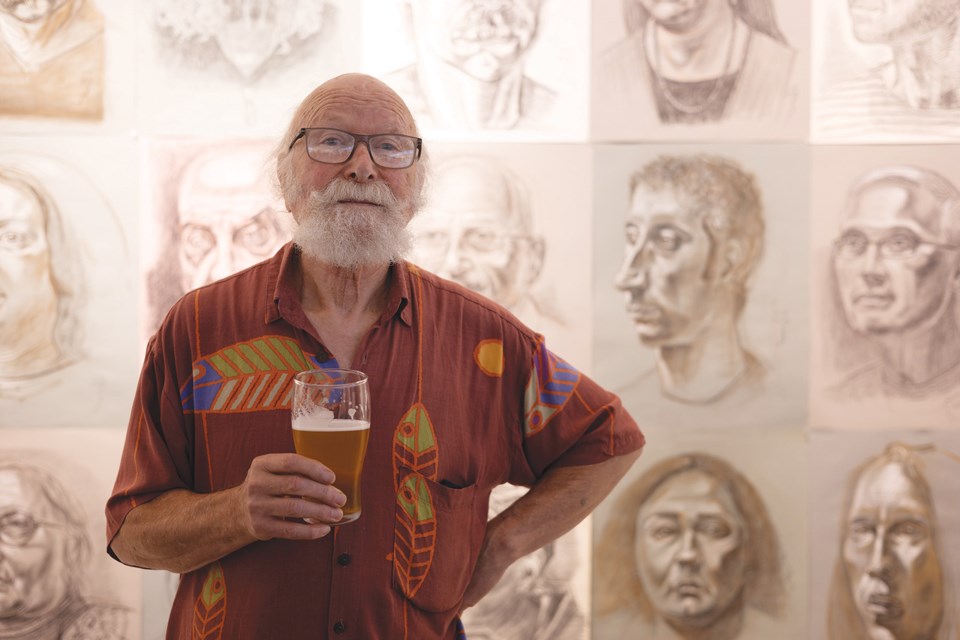The opening on Aug. 31 of an exhibition spanning four decades of portraiture by Maurice Spira, drew a crowd of familiar faces — and not only because so many of the admirers who packed the Gibsons Public Art Gallery are neighbours or friends of the Roberts Creek-based artist.
A sizeable proportion of the reception attendees were also subjects of the 130 paintings and drawings selected by Spira for public viewing during the three-week show.
“It’s just a fraction,” observed Spira. “I chose these with great difficulty. I wanted them to be strong drawings, strong portraits, but I also wanted them to work in other ways: well-balanced, structurally coherent, and all of those kinds of things.”
Spira’s works focus the light of inquiry on individuals’ faces and hands, with abstract backgrounds complementing the unique hues of each sitter’s peculiar physiognomy. Even the form of clothing is reduced to mere essentials — or eliminated altogether, as is sometimes the case in the more than two dozen autobiographical studies depicting Spira’s own progression through the seasons of life.
Spira describes himself as an artist, gardener (with a proclivity for red cabbages, potatoes and onions), and book collector. In a video documentary produced this year by director Caelan MacKenzie, filmed on location adjacent to Spira’s wood stove, propane cooker and packed bookshelves, he adds another layer of introspection: “I characterize myself as flying under the tripartite banner of the three “A”s: artist, anarchist and atheist. I have a very, very critical way of looking at all theologies and all doctrines.”
In his acrylic paintings, Spira’s variegated palette stems from the play of light on idiosyncratic wrinkles, furrows, jowls, and scars. His 2008 portrait of Peter Trower shows the ruddy veins of Trower’s hands converging on a folded book. Almost hidden behind broad-rimmed spectacles, the poet’s eyes focus in the middle distance with lips parted in a moment of rapt concentration.
The eyes of performer and artistamp pioneer Anna Banana, in Spira’s 2014 representation, confront the viewer directly, her somber expression providing a sagacious counterpoint to the cartoonish graphic over her shoulder. A portrait of writer David Roche appears at the gallery’s entrance, his cheeks and brow graven with labyrinthine lines that suggest the wear of empathy and the gravity of joy.
“The kind of person who hates to have their photograph taken is even more terrified of an artist examining their facial topography,” said Spira, who was born in Kent, England and emigrated to the West Coast in the early 1980s following an extended residency in Mexico. “There’s a couple of basic responses [from the subject of a portrait]: ‘I’ve got more hair than that.’ ‘My nose isn’t that long.’ Then, best of all, they’re silent and a tear will run down their cheek, and they will say: ‘There’s Uncle Jack. I see Uncle Jack.’ And then I’ll know that I picked something up.”
The exhibition includes gridworks of portraits drawn with conte crayon on paper, the monochromatic images depicting an encyclopedia of human experiences recorded in the folds of cheeks and sinews of necks. Spira’s body of work (shown most recently on the Coast during a 40-year retrospective in 2020) includes a variety of styles beside portraiture: book illustrations, block printing, and murals — notably a 1997 Sechelt skateboard mural that was banned for showing a skeleton skateboarding on a crucifix on wheels.
“Everything that I’m about is all to do with drawing,” Spira muses in the MacKenzie documentary. “My work is genuinely surrealistic in that my imagination is fully engaged.”
The Portraits exhibition continues at the Gibsons Public Art Gallery until Sept. 22. On Sept. 7, Spira will deliver a free public artist talk starting at 2 p.m.



